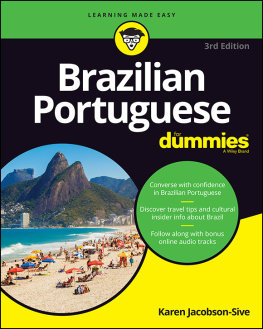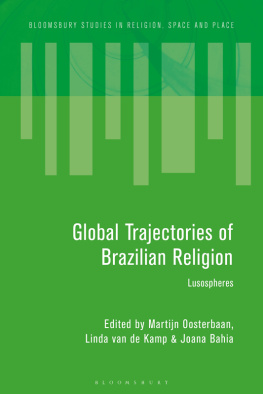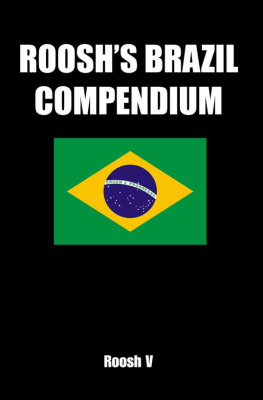THE

ESSENTIAL
BRAZILIAN
PORTUGUESE
BOOK
All you need to learn Brazilian Portuguese in no time
Fernanda Ferreira, PhD

Avon, Massachusetts
To my mother, Iracema, who was essential in my life.
Contents
Introduction
You picked up this book because you might have already watched a Brazilian movie, listened to a bossa nova song, or learned what capoeira means. Perhaps you already know that Brazilians love soccer and that they have won the World Cup five times. But you might still struggle with the Portuguese language, even if the Brazilian dialect sounds fascinating to you. Boas notcias! (Good news!) This book will help you in your journey to become more fluent in this beautiful language.
The chapters in this book cover everything from the origins of the Portuguese language to accent marks, formal greetings, various verb forms, and conjugations. The chapters on more discrete grammatical points are replete with practical, easy-to-follow exercises. The Answer Key (Appendix C at the back of the book) is available so you can check your work and evaluate your progress as you move through the chapters. There is no particular order in which you should read this book, although grammar topics are introduced in an increasing level of difficulty. That said, the instructions are easy enough that any reader should be able to grasp the content without having to refer constantly to previous pages.
Learners face many challenges as they try to master a new language. The most important element to remember is motivation. Research into second language acquisition has shown time and again that motivation is a crucial part of learner success. And that the establishment of clear goals from the beginning will also contribute to your success. Once you have decided what you want to get from this experience, devise a clear game plan, and set out to get it! Dont forget that practice makes perfect, so study for shorter time periods but study often!
As the author of The EverythingEssential Brazilian Portuguese Book, I hope that after you finish reading it you will have a better grasp of the intricacies of the Portuguese language, its pitfalls for the English speaker, and its unexpected beauty. At the same time, I hope that you will have a better understanding of what makes Brazilians who they really are.
CHAPTER 1
Introducing the Portuguese Language
Not many people know that Portuguese is spoken in Brazil, one of the few Latin American countries where Spanish is not the official language. In fact, Portuguese is spoken in far-reaching parts of the globe, such as Goa (India), Macau (China), Guinea-Bissau, Angola, and Mozambique, among other countries. So what are the origins of this language? How is it similar to or different from Spanish? What makes Brazilian Portuguese different from European Portuguese? And why should you learn it?
Why Learn Portuguese?
Have you ever listened to a bossa nova love song and wondered what the lyrics mean? Perhaps you have always been intrigued by fascinating exotic places such as the Amazon jungle or Copacabana beach. Maybe your grandparents emigrated from the Azores, Madeira, or Portugal, and you always wanted to write to them in their language. Or you might be interested in learning Portuguese to communicate with your coworkers.
Many people in the world (close to 200 million) speak Portuguese. You might be interested to know that many African and Asian countries have Portuguese as their official language. In addition, there is a growing Portuguese-speaking population in the United States. Because it is an uncommonly taught language, being fluent in it will probably serve you well when you look for a job! Also, learning Portuguese will help you understand the lyrics of famous bossa nova songs, the lines in Oscar-nominated Brazilian films, and the prose of an incredibly diverse body of literature.
Whatever the reason, be it reclaiming your heritage, learning more about the diversity of Latin America, or discovering new worlds of cuisine, literature, and history, learning Portuguese is a great step in your life. So put on your samba shoes and lets get started!
Similarities to Spanish
Portuguese and Spanish can be called sister languages due to their intrinsic similarities. After all, they both derive from spoken Latin. The following table shows the similarities in orthography between these languages.
 COMPARING PORTUGUESE TO SPANISH: PART I
COMPARING PORTUGUESE TO SPANISH: PART I
Portuguese | Spanish | English |
classe | clase | class |
casa | casa | house |
livro | libro | book |
caderno | cuaderno | notebook |
However, these similarities should not fool the serious Portuguese student. When using your knowledge of Spanish to help with your Portuguese, be mindful that these are different languages, and similarity in orthography does not always mean similarity in pronunciation. Always learn how to pronounce the sounds of Portuguese instead of relying on your Spanish. What about differences in words and meanings? The following list shows how these languages can vary significantly:
 COMPARING PORTUGUESE TO SPANISH: PART II
COMPARING PORTUGUESE TO SPANISH: PART II
Portuguese | Spanish | English |
cedo | temprano | early |
desenvolvimento | desarrollo | development |
envelope | sobre | envelope |
irm | hermana | sister |
If that wasnt enough, there are some tricky words that are commonly referred to as false cognates. These words sound similar to English or Spanish but mean something completely different in your target language, in this case, Portuguese. The novice student needs to watch out for these false friends.
 FALSE COGNATES
FALSE COGNATES
Portuguese | Spanish |
cuchilo (nap) | cuchillo (knife) |
tirar (to take) | tirar (to throw away) |
escritrio (office) | escritorio (desk) |
embaraada (confused, ashamed) | embarazada (pregnant) |
The trick here is to use a good Portuguese-English dictionary and always make sure you are saying the correct word, depending on the social situation. Some awkward moments may occur, but most of the time native speakers will understand and help you out.















 COMPARING PORTUGUESE TO SPANISH: PART I
COMPARING PORTUGUESE TO SPANISH: PART I